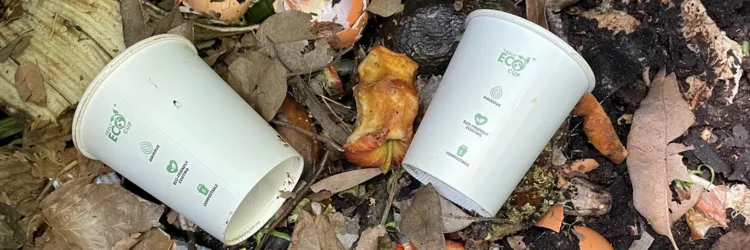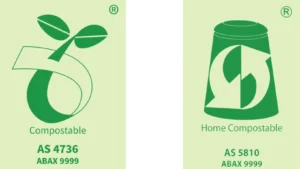Compostable plastics

Are compostable plastics the best option?
Compostable plastics are becoming more common and can appear to be an intuitive solution to plastic pollution, but are they the best option?
In order to carry the official “seedling logo”, compostable products must be certified, which confirms they’ve undergone stringent testing and have met Australian Standards. However certification isn’t compulsory, and Australia has no mandatory standard on biodegradability or degradability. And to make matters even more confusing, products that have been officially certified as “compostable” can’t be composted in your own compost bin at home!
UNDERSTANDING “COMPOSTABLE” VS “HOME COMPOSTABLE”
For a product or packaging to be verified compostable according to the Australian Standards, it must biologically disintegrate and biodegrade in the relevant composting system to set levels within a defined period of time.
“Home-compostable” plastics are designed to be composted at ambient temperatures with a natural microbial community, while “compostable” plastics require increased temperatures, humidity, and specifically formulated microbial conditions.
Products that meet Australian Standard (AS) 4736–2006 are recognised by having the ‘seedling logo’ printed on them. They are suitable only for commercial composting.
The Home Compostable Verification logo is a symbol that the product’s claims of biodegradability and compostability as per (AS) 5810-2010 has been verified.
Keep an eye out for these symbols which confirm products have been officially verified:

COMPOSTABLE PLASTICS NEED TO BE SENT TO INDUSTRIAL COMPOSTING FACILITIES
If plastic is labelled “certified compostable” (Australian Standard 4736-2006 and has the seedling logo), it can’t be composted at home, it will need to go to a commercial composting or organics recycling facility.
In one study, compostable plastic bags buried in soil for three years were so sturdy they could still hold a full load of groceries. In another study, a type of compostable plastic submerged in seawater did not show any signs of degradation 428 days later.
A commercial facility provides controlled conditions and speeds that timeline up to just a few months, by a multi-step process requiring temperatures of 60 degree C, with measured inputs of water, air, as well as carbon and nitrogen-rich materials.
COMPOSTABLE PLASTICS CAN NOT GO IN ALL FOGO BINS
The NSW Environment Protection Authority (EPA) recently clarified its guidelines around what was allowed in FOGO bins, banning items including “compostable or biodegradable plastic products or bags”.
Compostable plastics are currently accepted in FOGO bins in South Australia and some councils in Hobart. But everywhere else, access to these services is limited. Many councils in other states will accept food and green waste – but specifically exclude compostable plastics (some including NSW councils accept council-supplied food waste caddy liners).
Without widely available pathways to compost or process “compostable plastics” at the end of their lives, it means they nearly always end up in landfill.
COMPOSTABLE PLASTICS ARE A BIG PROBLEM IN LANDFILL
Compostable plastics can not only take more than a century to break down when buried in landfill, but like food waste, they also emit methane, a potent greenhouse gas that contributes significantly to global warming. In fact methane gas emitted from landfills is a major contributor to climate change and a U.N. report published in 2021 found that immediate reductions in methane emissions is the strongest lever we have to slow climate change. By comparison, conventional plastics are inert in landfills.
COMPOSTABLE PLASTICS CAN NOT BE RECYCLED WITH OTHER PLASTICS
Due to their different composition, compostable plastics cannot be recycled in with other plastics. Their materials have different properties and would contaminate other conventional plastics if they were mixed together. Unfortunately, compostables often well-meaningly find their way into recycling streams, contaminating full batches of recycling and condemning them to landfill.
COMPOSTABLE PLASTICS ARE BAD NEWS IN THE ENVIRONMENT
Sadly, a turtle can choke just as easily on a littered compostable plastic bag as a conventional plastic bag.
COMPOSTABLE PLASTICS AND THE CIRCULAR ECOCOMY
The move to a circular economy is about eliminating waste and pollution, and that includes greenhouse gas emissions. A circular economy aims to keep materials in the productive economy and decrease the need for new materials. Any time a compostable plastic item is used once – no matter how it is disposed of – it is still a single-use plastic.
Where possible, we should be choosing products and packaging that can be reused, which will mean less single-use packaging being manufactured and less waste going to landfill or litter.
